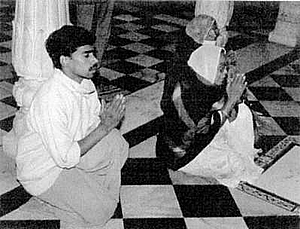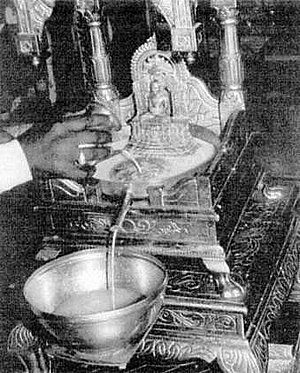The rite begins with a succession of welcoming flower offerings (kusamanjali) made to each of five Tirthankars (Rsabh, Santinath, Neminath, Parsvanath, and Mahavir). The "flowers" consist of saffron-colored rice which may be mixed with cloves or real flowers. Worshipers stand, holding the "flowers," while singing lines of praise from the text. Then comes a formula of offering, at which point the "flowers" are deposited at the image's feet. After each of these offerings, worshipers apply spots of sandalwood paste to the image's body: after the first offering, to the feet, next to the legs, and then to the hands, shoulders, and head. At the conclusion of the five offerings, celebrants sing the Tirthankars' praises, and some wave or dance with whisks known as camars.
Now begins the rite's narrative, which is the story of the holy birth and first bath. As the story unfolds, the participants take on the personae of gods and goddesses who assist in, and celebrate, the events depicted. I now describe the actions of participants and summarize the text.
Worshipers stand with flower offerings in their hands. The story opens. The text begins by telling of how a Tirthankar-to-be earns the tirthankar nam karm in the third birth before his incarnation as a Tirthankar, and how he takes human birth in a kingly family in the continents Bharat, Airavat, or Mahavideh. At the time of his descent into a human womb his mother is visited by the fourteen auspicious dreams (listed in the text).[1] She informs her husband. He declares that she will give birth to an "honor-mark of the three worlds" who will establish the path to liberation. Then the throne of the Indra of the first heaven shakes; he sees the descent by means of the clairvoyant knowledge he possesses as a god and knows that a great savior has come into existence. He rises from his lion-throne and closes his hands in salutation. He steps forward, bows, and then announces the descent to the gods. He sings a hymn of praise. There is rejoicing in heaven and in the mother and father's house, and all the beings of the three worlds (including the denizens of hell) experience an instant of happiness. Cries of felicitation ring out everywhere.

Figure 6.
Participants in a snatra puja performing caitya vandan in
Jaipur. Note the special posture, prescribed for caitya vandan, with the left
knee raised.
At this point participants make a congratulatory offering of the flowers to the image, and then circumambulate the image three times. Then, while seated in a special posture, they recite (or one among them recites) a caitya vandan or a portion of it (Figure 6). Commonly, participants recite the Namutthunam Sutra (also known as the Sakra-stava), which is believed to be sung by Indra at the time of a Tirthankar's conception.[2] They then wash and dry their hands. They mark their right hands with svastiks, tie ceremonial strings on their right wrists, and stand ready for the next phase of the rite.
The tale resumes. The fifty-six Dikkumaris (a category of goddesses) learn of the birth by means of their clairvoyant knowledge. Singing praises, they go to the mother and clean impurities from the site of the birth. At this point human worshipers make a gesture of cleaning the floor before the image. The Dikkumaris light a lamp. Worshipers likewise show a lamp. The Dikkumaris display a mirror. Worshipers do the same. The Dikkumaris fan the mother and child. Worshipers wave a fan. The Dikkumaris fashion a house from banana trees and bathe the mother and child within. Then they tie a protective thread on the child's wrist. At this point worshipers place a ceremonial string on the image's lap.
On the night of the Lord's birth, says the text, there is brilliance everywhere,[3] and at the auspicious moment of birth Indra's throne trembles. Wondering what "opportunity" (avsar) has arisen, Indra learns of the birth by means of his clairvoyant knowledge and is filled with the highest bliss. To announce the birth he causes a bell to be rung. At this point worshipers ring a bell. Indra then goes to the summit of Mt. Meru and orders the other gods to do the same; by washing the Lord's feet, he says, they will wash their sins away. Tens of millions of gods assemble there. Now Indra goes to the Lord's mother and does obeisance. The worshipers now make a flower offering. He explains that he will convey the infant to Mt. Meru. Taking the child in his hands, he multiplies himself into five Indras who bear the child to the mountain. There the waiting gods and goddesses sing, dance, and praise the infant as the teacher and Lord of the world and as their shelter and support. At this point worshipers dance.
Indra takes the infant to the Panduk Grove,[4] where he seats himself on a lion-throne with the infant on his lap. The other sixty-three Indras arrive. Acyutendra, the lord of the eleventh and twelfth heavens, orders tens of millions of gods and goddesses to bring water for the Lord's bath. With hands joined in salutation, they obey. The human worshipers now stand ready with water pots.
The gods go to the milky ocean and all the great pilgrimage places on watercourses in order to obtain pure water and other things needed for the Lord's bath. One thousand and eight pots of eight different kinds are prepared. The gods return, and when they see the Lord in Indra's lap their hearts are filled with ecstasy. Acyutendra exhorts all gods to take the Lord's darsan. Then, at his command, they stand ready with pots in hand. The gods ask the Indra of the first heaven, "Who is that wondrous form in your lap?" Indra answers that it is the world's savior and tells them to perform abhisek�that is, to pour liquid on the infant. They do so. At this point the human worshipers, following the divine model described in the verses, pour water on the image's feet.
The Indra of Isan Devlok (the second heaven) now asks the Indra of the first heaven if he might hold the infant for a while. Permission granted, he does. Worshipers again pour water on the image's feet, and, as the story continues, the worshipers pour water and milky water over the entire image (Figure 7). On special occasions they anoint the image

Figure 7.
Bathing the image in snatra puja. Note the seated im-
age of the Tirthankar with the flat siddhcakra below.
with what is called pancamrt, a mixture of five substances: milk, curds, sugar, saffron, and clarified butter. Participants take turns in the pouring, and sometimes several participants at once touch the pot as the water is being released. The basic idea is that everyone should take part in the bathing. The image's final bath is with plain water.
The text continues. The Indra of the first heaven takes the form of four bulls and pours water over the Lord from the eight horns. Worshipers often imitate this act by pouring water on the image from a bull-shaped pot. Afterwards Indra garlands and ornaments the infant. The assembled gods cry "victory" and dance: The "chief of the convoy" on the road to liberation has come. They then give a gift of 320 million golden coins. At this point a worshiper circles a coin in the air before the image (a gesture known as nyauchavar) and deposits it in the bowl into which the run-off liquids from the image's bath have been collecting. Indra returns the infant to his mother's lap, and then goes to Nandisvar to worship the eternal Tirthankar images there. The gods return to their normal abodes while saying how much they look forward to the kalyanaks of the Lord's initiation and attainment of omniscience.
At the end of the text Devcandraji identifies his disciplic lineage and names himself as the composer of the rite. Those worthy (bhavya) beings, he says, who perform this birth-rite will plant the seeds of the tree of enlightenment in their hearts and will fill the sangh (the Jain community) with bliss. The final lines are an exhortation to perform the Lord's puja; it benefits one's soul and carries one across the ocean of existence. Afterwards the image is carefully wiped dry and replaced in its former position. The snatra puja proper is followed by a version of the eightfold worship, the astprakari puja (to be described later in this chapter). Sometimes, especially when the snatra puja is being performed in conjunction with a major congregational ceremony, the offerings given in the eightfold worship are quite festive and elaborate. The entire series normally concludes with lamp offerings (arati and mangal dip).
 Prof. Dr. Lawrence A. Babb
Prof. Dr. Lawrence A. Babb
